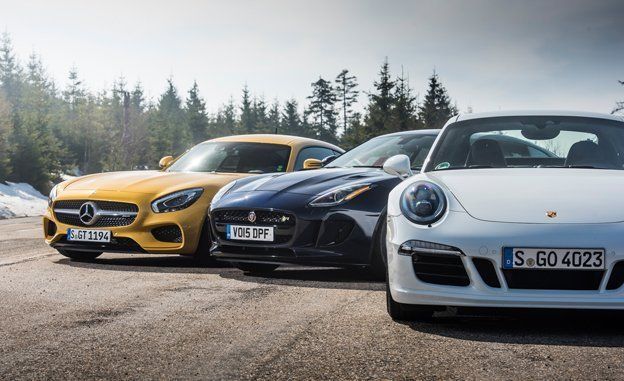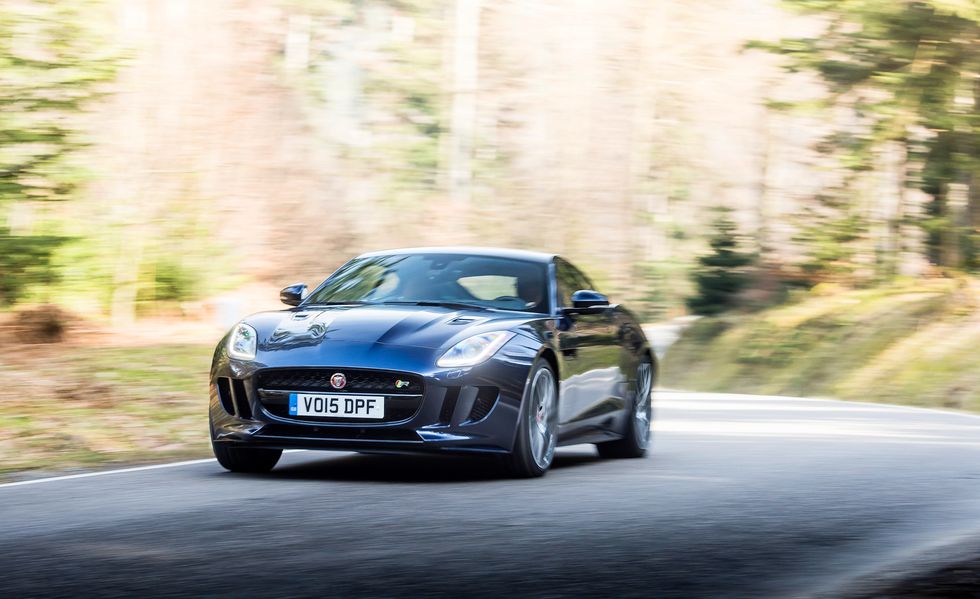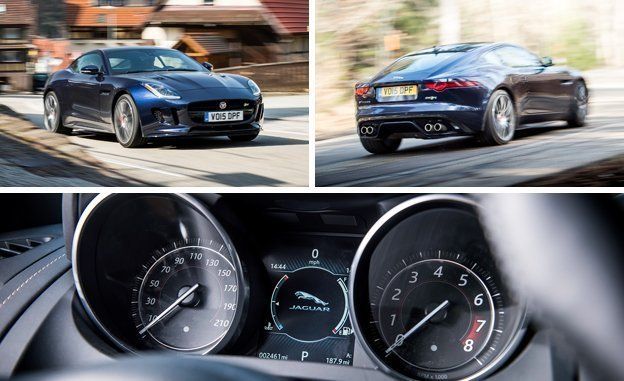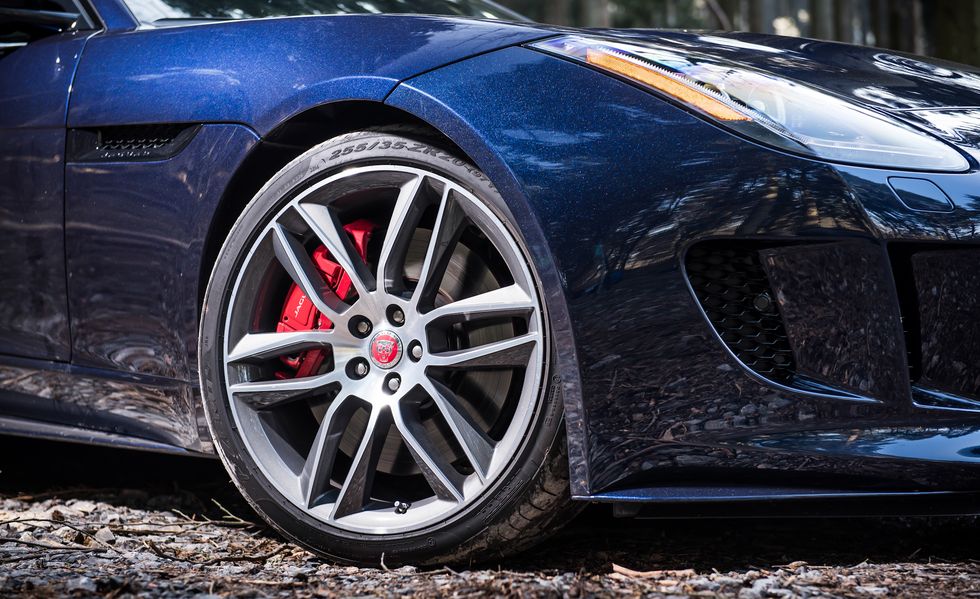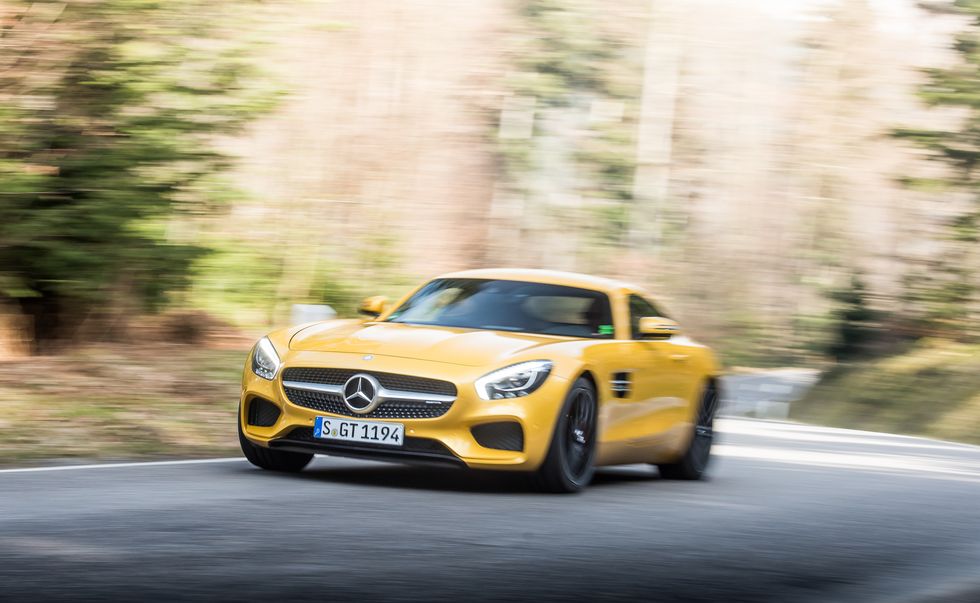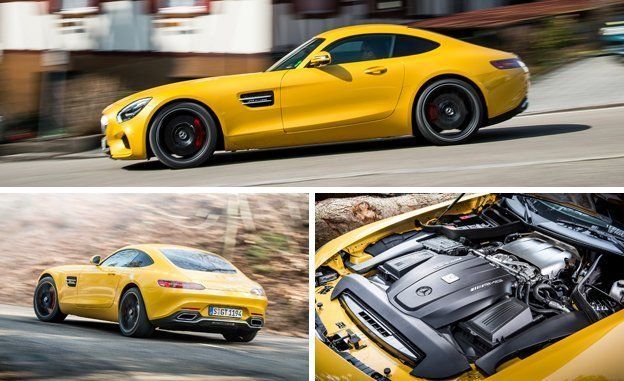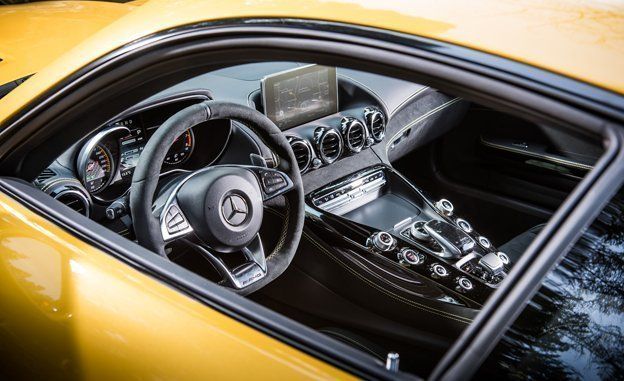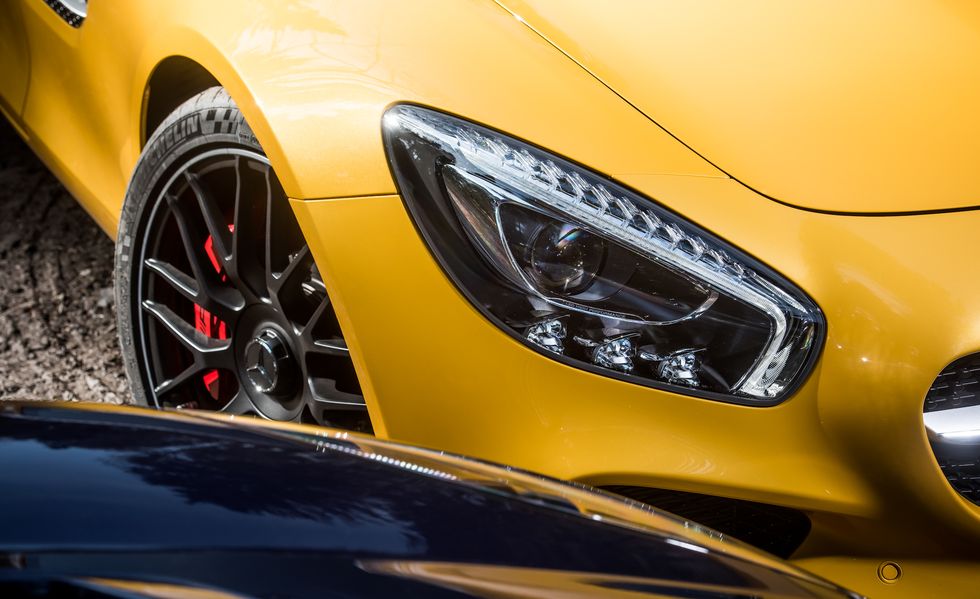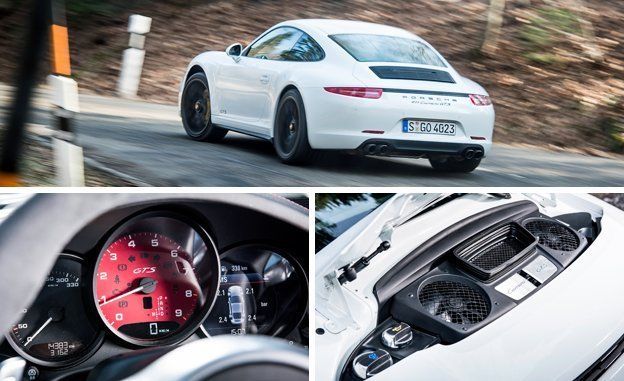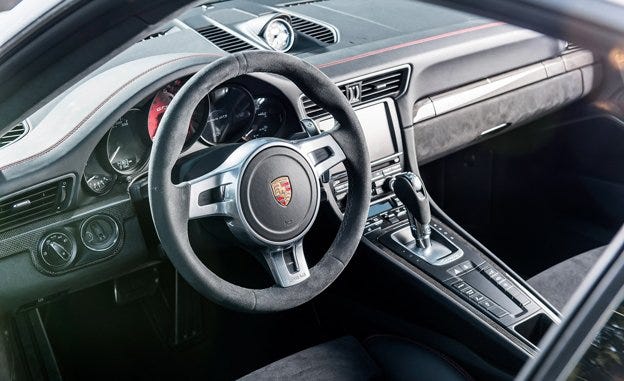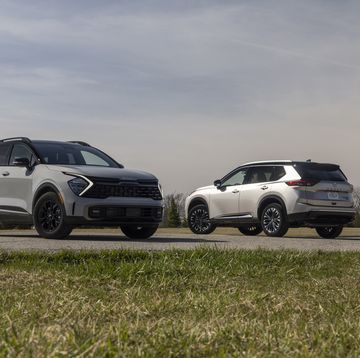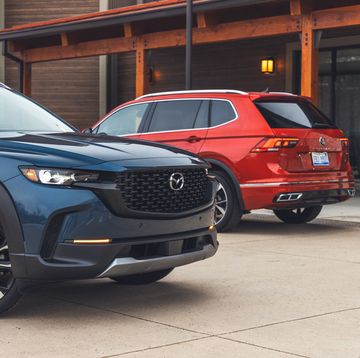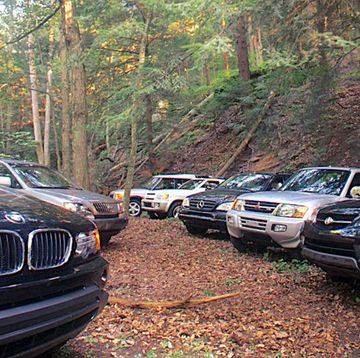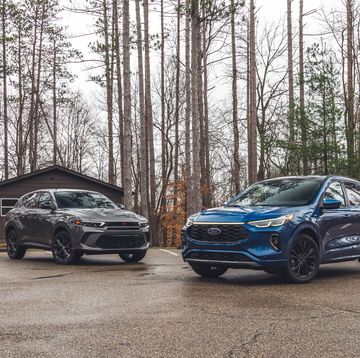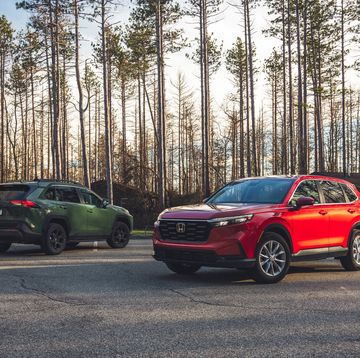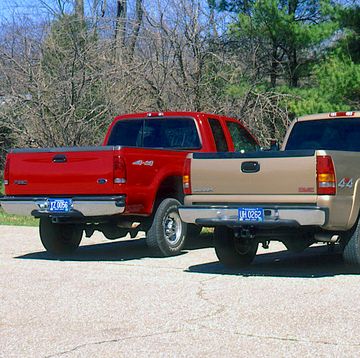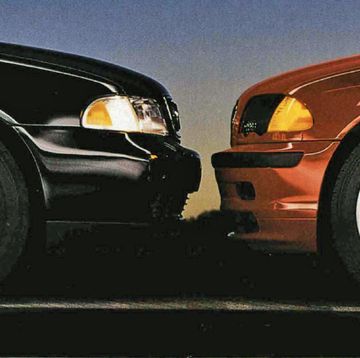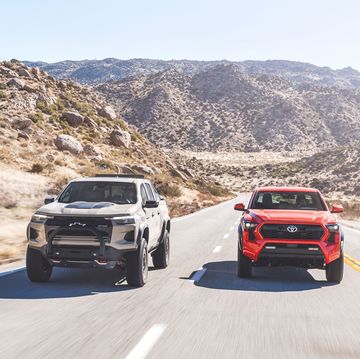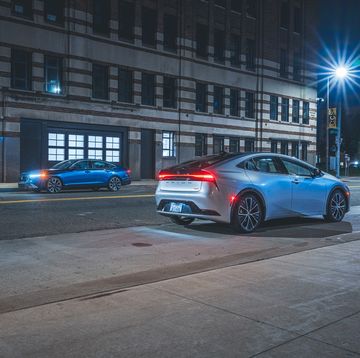From the June 2015 issue of Car and Driver.
For the last five decades, the toughest question for any buyer of a high-end sports car has been: “How do I not end up with a 911?” To describe Porsche’s most famous product as a default choice is a faint-praise damning of what has become the world’s most iconic sports car. But it’s also an acknowledgment that to get a car as capable and well-rounded as a 911, you have to get, well, a 911.
There have been many challengers, of course, including one made by Porsche itself (the 928). But despite what every boxing movie has assured us about plucky underdogs, none have succeeded in wholly unseating this champ, certainly not in the hearts of the people who actually write checks for real cars. It’s a point proven by a trawl around the paddock of any upmarket track day or the parking lot of any plastic surgeon’s clinic.
Only now, for the first time, the 911 faces a direct challenge from Stuttgart’s other native carmaker. Having failed to set the supercar world alight with the gullwing SLS, Mercedes-Benz has opted to move down a segment with the AMG-engineered GT, a car that targets the 911 with almost stalkerlike intensity. The range-topping GT S we’re testing here has the most powerful version of AMG’s new 4.0-liter twin-turbocharged V-8—503 horsepower—and it carries a base price of $130,825, which buys what is, by the sometimes stingy a la carte standards of the segment, a rather generous list of amenities.
All of which limits our choice of 911. The 520-hp 911 Turbo is closest in terms of pure oomph, but it is about $20,000 more expensive before you’ve ticked a single option box. The Carrera GTS is $15,000 cheaper than the AMG GT S, but well down on power. Knowing that even a moderate options workout would push the Porsche beyond price parity with the Mercedes-AMG, that’s the version we picked. Despite its name, the GTS is more of a Carrera S-plus than a junior GT3, bringing the fractionally wider Carrera 4 bodyshell and the drive-sharpening Sport Chrono kit and PASM adaptive suspension, plus a 30-hp increase in output to 430.
That brings us to the odd one out, because it’s not German and not rear-wheel drive—but it’s still the next-closest thing to a 911. Despite being on sale for less than a year, the Jaguar F-type R coupe has just received a four-wheel-drive system that will, henceforth, be standard on all U.S. versions. In this company, it’s a performance bargain, with a 550-hp version of Jaguar’s supercharged V-8 and a $104,595 base price. And when we requested a representative U.S.-spec car in Germany, Jaguar went to the considerable trouble of shipping this one straight from the factory, complete with Yankee-red rear turn signals and a navigation unit that reckoned we were 4000 miles from the nearest road.
After gathering performance figures on the runway of the Adolf Würth Airport, our chosen driving location is the Black Forest, about an hour west of Stuttgart and home to most of Germany’s spa towns, from Baden-Baden to Bad Herrenalb and even Bad Wildbad, which is so Bad it has to be good. The region is also known for its eponymous kirsch-soaked cake that, by trying really hard, we managed to avoid. A home-field advantage to the Germans then, although some of the mountain roads around here would be considered driving nirvana wherever they were situated. Let the battle rage.
3rd Place:
Jaguar F-Type R Coupe
There’s a lot to like about the F-type R coupe, but it finishes a distant third here, coming across the line whole seconds after the flash that barely separates the Porsche from the Mercedes.
Next to its Teutonic rivals, the Jaguar feels unpolished and slightly ill-mannered. It’s never less than exciting, including when you don’t want it to be. The suspension firmness is punishing on anything other than glass-smooth surfaces, refinement is lacking, and the cabin so tight that it’s more worn as a sarong than sat in. But the R’s party piece comes when you lift off the throttle in dynamic mode. You’re greeted by a fusillade of pops and bangs that sounds as if you’re driving past a drunken firing squad. It’s practically guaranteed to get you a snotty letter from the local resident association, if not from neighbors one town over.
HIGHS: Looks great, attractively priced, ridiculously fast.
LOWS: Cramped, crude and rude.
VERDICT: A diamond that lacks polish.
The Jag’s four-wheel-drive system is of the part-time variety, with an electronic clutch pack only directing torque to the front wheels when it needs to. It tamed the R coupe noticeably when compared with its rear-driven predecessor, a car that, under full throttle, we found felt like a rocket-propelled grenade. But even with the stability-control system switched on, we found the F-type’s dynamic mode allowed a surprising amount of lateral slip, even on the dry pavement of our Swabian playground. Roll on too much power in a slower turn, and there’s a disconcerting wait after the rear of the car starts to slide before the combined efforts of the four-wheel-drive and stability systems step in to straighten things out. It’s a dynamic characteristic we fear will be responsible for a number of soiled golf pants. This definitely isn’t the sort of four-wheel drive that gets you through a New England winter drama-free.
To be fair, the Jaguar is also exciting when you want it to be. And on the right road, with your reactions turned up to max, it’s a responsive and rewarding companion. The steering offers fractionally more communication than either of the Germans, and the minimal distance between seat and rear axle delivers instant telemetry through your arse-antenna. It’s easy to get the F-type into its groove, driving to its well-flagged limits of adhesion, and then using the throttle to adjust your cornering line.
It’s quick, too. The Jaguar’s porky 4088-pound curb weight means it’s not as fleet as the less powerful Mercedes-AMG. But although beaten at the track, the F-type on real German roads never felt left behind. Credit goes to the V-8’s brawnier mid-range responses. Unfortunately, the Jag’s gearchanges feel clean but slow-witted compared with those of the dual-clutch gearboxes in both the Porsche and the Merc. And though it stops well, recording a 137-foot 70-to-zero distance, the brake pedal feels disappointingly rubbery in this company.
It’s also a packaging disaster. The F-type is just three inches shorter than the AMG and less than an inch narrower, but the cabin feels at least a segment smaller, with a low roof and a fat transmission tunnel bequeathing a driving position that could be politely described as cozy (and impolitely as cramped and uncomfortable). The coupe’s hatch gives it more luggage space than its roadster sister offers, but much of the space behind its seats is taken up by the extra structure that Jaguar needed to create the tin-top, which goes most of the way to the roof. In the AMG, there’s just a half-height bulkhead and a brace between the rear-spring towers.
Much as we would love for an outsider to beat the Germans on their home turf, it’s not going to happen this time.
2nd Place:
Mercedes-AMG GT S
Devastatingly handsome in its own right, the GT’s design tells a bigger story than the official one about emotional tension and muscular proportions. It pretty much looks like an SLS at the front and a wannabe Porsche at the rear, meaning it’s a synthesis of design DNA that properly reflects the spirit of the car.
The bodywork is by no means “wrapped around the mechanicals,” a phrase we hear issuing from the mouths of so many designers. Open the long hood and you’ll find what appears to be a plastic engine cover. Unclip this and you’ll discover it shields nothing more than the coolant reservoir and expansion tank. The twin-turbocharged V-8 is so compact that it sits several inches aft of the axle line, well behind this faux shroud. Mercedes could have easily made the GT a couple of feet shorter, but it presumably didn’t want it to look underendowed next to the grandly phallic SLS AMG.
HIGHS: Storming performance, crowd-stopping looks.
LOWS: Too big to be truly agile.
VERDICT: The most exciting Mercedes sports car since the original Gullwing.
And despite being nearly $100,000 cheaper than the recently retired SLS, the GT S is no poor relation. In addition to being the quickest car in this test across the board, it also outsprints the SLS. In our testing, we recorded a blistering 3.0-second zero-to-60 time, two-tenths quicker than even the megapriced SLS AMG Black Series. Both cars manage identical 11.2-second quarter-miles.
The GT S’s cabin feels better finished and better equipped than the SLS’s ever did, and the hatchback rear makes it vastly more practical. Other than the gullwing doors, you’re really not missing much. But can it deliver on the other part of its mission, to beat the 911? In terms of raw firepower, absolutely. The V-8 is definitely the most charismatic engine here, rumbling like a straight-piped brodozer at low speeds, then delivering some proper thunder when worked hard. It pulls cleanly and without lag, and although it might lack some low-down enthusiasm compared with the compressor-fed F-type, it revs higher and more relentlessly. It even pulls hard beyond 6600 rpm, where the Jaguar calls time.
The AMG’s dual-clutch gearbox isn’t as refined as the 911’s PDK, with some noticeable clunks as it shuffles between first and second at low speed. But with one of the more aggressive drive programs selected through the rotary controller—which cycles through individual, comfort, sport, sport-plus, and race modes—gearchanges become brutally fast and accompanied by a head-bobbing torque bump that makes them feel even quicker.
The GT S, though, can’t match the 911 for outright agility, the critical sports-car attribute. At regular speeds, it feels big and broad. It barely fit in some of Germany’s narrow traffic lanes. On the more demanding mountain roads, moving faster, it does pull off that old cliché of shrinking around you. That said, it never feels as nimble or wieldy as the 911, although it’s easily placed and sticks to a chosen line like a scandal. Grip levels are immense, and the stability control keeps the GT S under iron discipline. Lean on it as hard as you dare and it won’t slip. Most of the time, fun is what happens between the corners.
You have to switch to the more permissive sport-handling mode if you want to rouse the chassis, thereby revealing a willingness to take instruction from the back end in a benign and predictable manner. Switch the stability off, and it becomes a tire-smoking Visigoth. It’s a hugely exciting car, viscerally thrilling. It also drew crowds every time we stopped, with the spectators pretty much ignoring the two other cars. But in the ultimate analysis, it’s not the finely honed driving instrument that even the fourth-from-the-top 911 is, and that’s why Mercedes-AMG gets beaten here.
1st Place:
Porsche 911 Carrera GTS
The 911 has always stood against automotive evolution as a rear-engined Paleolithic leftover that, like an alligator, just works. And although we wouldn’t dare to criticize the decision to leave the flat-six engine in the space most cars reserve for groceries or kidnapped mafia rats, we can state that, despite bringing 430 horsepower to the party, the GTS feels almost embarrassingly underpowered in this company.
It’s quite the knife-at-a-gunfight disparity. And the difference on the road is even more obvious than it is on the VBOX; you can exit a corner in the Porsche mere inches behind the GT S and be looking at a gap of yards within seconds.
HIGHS: A precision driving instrument.
LOWS: Outgunned by boosted rivals.
VERDICT: A slightly better version of the Carrera S.
As you’d expect, the Porsche makes up for its performance discrepancy in lots of other ways. Indeed, in almost all other ways. It has the most grip here and the most proficiency going around corners. Almost all the old 911 dynamic foibles have been systematically engineered out of the 991-generation car, but the aft-heavy weight distribution still makes its presence felt in longer turns, getting all its power to the road, and supplying the slightly magical ability to influence the cornering line with minimal inputs. A fractional lift off the throttle, or a couple grams of extra pressure on it, can have as much effect as attempting to stomp the gas pedal through the carpet in our other challengers.
What’s good is still great. The Porsche’s engine, though lacking firepower here, is still a masterpiece. It loves to rev, and it has a perfectly proportionate throttle response that makes even the AMG feel slightly hesitant. We loved its yowling hard-edged soundtrack, too, with a blast through the mile-long tunnel beneath the doubly bad burg of Bad Wildbad confirming it. Our test car came with the optional seven-speed dual-clutch that swaps ratios cleanly and quickly, even if it does default to shifting into the highest gear possible when left in its auto mode (do yourself a favor and select sport or sport-plus mode every time you enter), creating an unseemly scramble for kickdowns when you want to stir things to life. Oh, and the 911 also has the best shift paddles, possibly as atonement for the horrible rocker switches once fitted to Tiptronics. They are longer and heavier than the Jaguar’s plastic-feeling ones and have a more substantial action than those in the AMG.
There’s no doubting that the GTS is some way from the top of the 911 tree. Other than a red rev counter and GTS-branded sill protectors, it feels like any other mid-ranking 911: comfortable and well finished but far more functional than the flamboyant Mercedes. And although we love its free-revving engine dearly, we can understand why—beyond just economy standards—Porsche will soon be replacing it with a brawnier turbocharged powerplant. But even outgunned as it is, this is still the best-driving high-end sports car extant.
| Vehicle | 2016 Jaguar F-type R Coupe | 2016 Mercedes-AMG GT S | 2015 Porsche 911 Carrera GTS | |
| Base Price | $104,595 | $130,825 | $115,195 | |
| Price as Tested | $110,845 | $151,075 | $138,750 | |
| Dimensions | ||||
| Length | 176.0 inches | 179.0 inches | 177.5 inches | |
| Width | 75.7 inches | 76.3 inches | 72.9 inches | |
| Height | 51.6 inches | 50.7 inches | 51.0 inches | |
| Wheelbase | 103.2 inches | 103.5 inches | 96.5 inches | |
| Front Track | 62.4 inches | 66.1 inches | 60.6 inches | |
| Rear Track | 64.1 inches | 65.0 inches | 61.4 inches | |
| Interior Volume | F: 52 cubic feet | F: 55 cubic feet* | F: 50 cubic feet R: 17 cubic feet* | |
| Cargo | 11 cubic feet | 12 cubic feet | 14 cubic feet | |
| Powertrain | ||||
| Engine | supercharged DOHC 32-valve V-8 305 cu in (5000 cc) | twin-turbocharged DOHC 32-valve V-8 243 cu in (3982 cc) | DOHC 24-valve flat-6 232 cu in (3800 cc) | |
| Power HP @ RPM | 550 @ 6500 | 503 @ 6500 | 430 @ 7500 | |
| Torque LB-FT @ RPM | 502 @ 3500 | 479 @ 1750 | 325 @ 5750 | |
| Redline / Fuel Cutoff | 6600/6600 rpm | 7000/7000 rpm | 7600/7900 rpm | |
| LB Per HP | 7.4 | 7.3 | 7.6 | |
| Driveline | ||||
| Transmission | 8-speed automatic | 7-speed dual-clutch automatic | 7-speed dual-clutch automatic | |
| Driven Wheels | all | rear | rear | |
| Gear Ratio:1/ MPH Per 1000 RPM/ Max MPH | 1. 4.71/6.6/44 2. 3.14/10.0/66 3. 2.11/14.6/96 4. 1.67/18.3/120 5. 1.29/23.7/156 6. 1.00/30.0/186 7. 0.83/36.0/186 8. 0.67/46.0/186 | 1. 3.40/6.3/44 2. 2.19/9.9/70 3. 1.63/13.2/93 4. 1.29/16.7/117 5. 1.03/20.5/144 6. 0.84/26.3/184 7. 0.63/34.2/193 | 1. 3.91/5.9/47 2. 2.29/10.1/80 3. 1.65/13.9/110 4. 1.30/17.7/140 5. 1.08/21.5/170 6. 0.88/26.0/189 7. 0.62/37.3/175 | |
| Axle Ratio:1 | 2.56 | 3.67 | 3.44 | |
| Chassis | ||||
| Suspension | F: multilink, coil springs, anti-roll bar R: control arms, coil springs, anti-roll bar | F: control arms, coil springs, anti-roll bar R: control arms, coil springs, anti-roll bar | F: struts, coil springs, anti-roll bar R: multilink, coil springs, anti-roll bar | |
| Brakes | F: 15.0-inch vented disc R: 14.8-inch vented disc | F: 15.4-inch vented, cross-drilled, grooved disc R: 14.2-inch vented, cross-drilled, grooved disc | F: 13.4-inch vented, cross-drilled disc R: 13.0-inch vented, cross-drilled disc | |
| Stability Control | fully defeatable, competition mode | fully defeatable, competition mode, launch control | fully defeatable, competition mode, launch control | |
| Tires | Pirelli P Zero F: 255/35ZR-20 (97Y) R: 295/30ZR-20 (101Y) | Michelin Pilot Super Sport F: 265/35ZR-19 (98Y) R: 295/30ZR-20 (101Y) | Pirelli P Zero F: 245/35ZR-20 (91Y) R: 305/30ZR-20 (103Y) | |
| C/D Test Results | ||||
| Acceleration | ||||
| 0–30 MPH | 1.3 sec | 1.3 sec | 1.4 sec | |
| 0–60 MPH | 3.4 sec | 3.0 sec | 3.6 sec | |
| 0–100 MPH | 8.0 sec | 6.9 sec | 8.5 sec | |
| 0–130 MPH | 13.7 sec | 11.7 sec | 14.6 sec | |
| ¼-Mile @ MPH | 11.7 sec @ 122 | 11.2 sec @ 127 | 11.9 sec @ 118 | |
| Rolling Start, 5–60 MPH | 3.9 sec | 3.7 sec | 4.2 sec | |
| Top Gear, 30–50 MPH | 2.2 sec | 2.1 sec | 2.7 sec | |
| Top Gear, 50–70 MPH | 2.8 sec | 2.4 sec | 2.8 sec | |
| Top Speed | 186 mph (gov ltd, mfr's claim) | 193 mph (gov ltd, mfr's claim) | 189 mph (drag ltd, mfr's claim) | |
| Chassis | ||||
| Braking 70–0 MPH | 137 feet | 141 feet | 136 feet | |
| Roadholding, 200-ft-dia Skidpad | 1.00 g | 1.05 g | 1.06 g | |
| 610-ft Slalom | 43.4 mph | 45.2 mph | 46.2 mph | |
| Weight | ||||
| Curb | 4088 pounds | 3677 pounds | 3276 pounds | |
| %Front/%Rear | 54.5/45.5 | 47.5/52.5 | 37.7/62.3 | |
| Fuel | ||||
| Tank | 18.5 gallons | 17.2 gallons | 16.9 gallons | |
| Rating | 91 octane | 91 octane | 93 octane | |
| EPA City/Hwy | 15/23 mpg | 16/24 mpg* | 19/26 mpg | |
| C/D 275-Mile Trip | 11 mpg | 11 mpg | 13 mpg | |
| Sound Level | ||||
| Idle | 47 dBA | 54 dBA | 54 dBA | |
| Full Throttle | 83 dBA | 90 dBA | 89 dBA | |
| 70-MPH Cruise | 72 dBA | 74 dBA | 75 dBA | |
*C/D estimated. | ||||
tested in Schwäbisch Hall, Germany, by Eric Tingwall | ||||
Our man on the other side of the pond, Mike Duff lives in Britain but reports from across Europe, sometimes beyond. He has previously held staff roles on U.K. titles including CAR, Autocar, and evo, but his own automotive tastes tend toward the Germanic: he owns both a troublesome 987-generation Porsche Cayman S and a Mercedes 190E 2.5-16.


